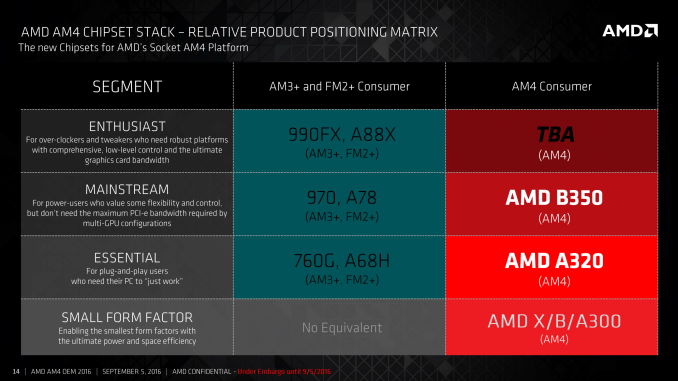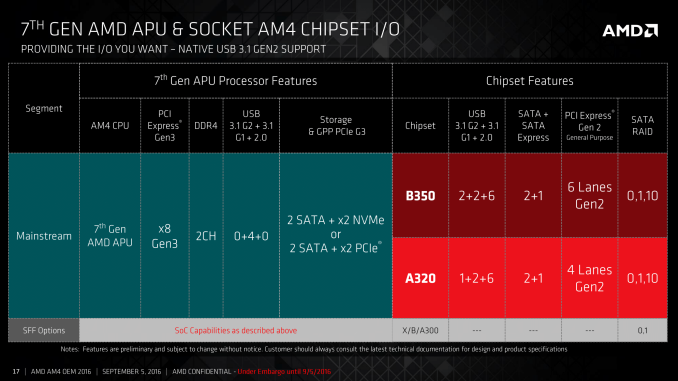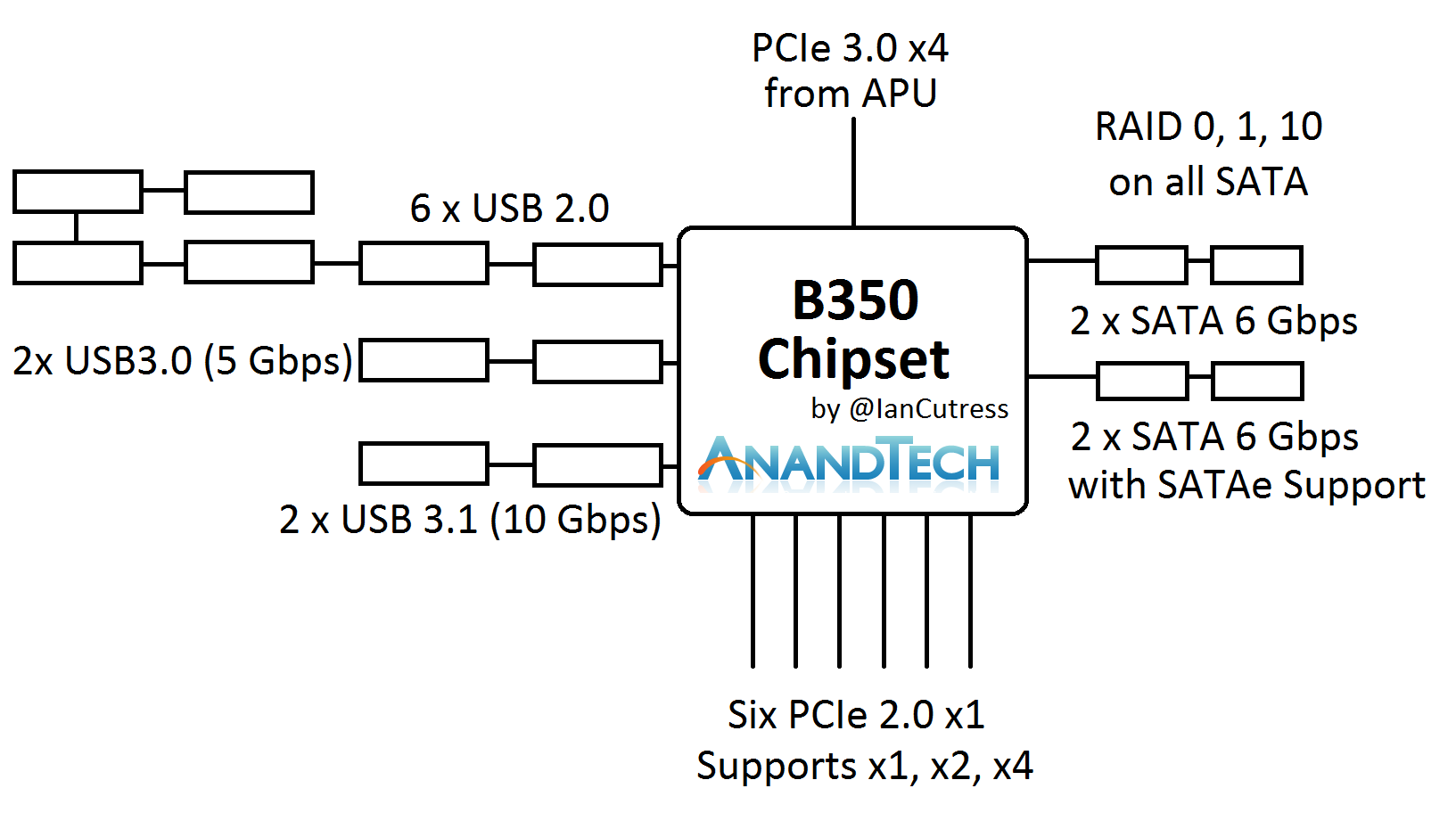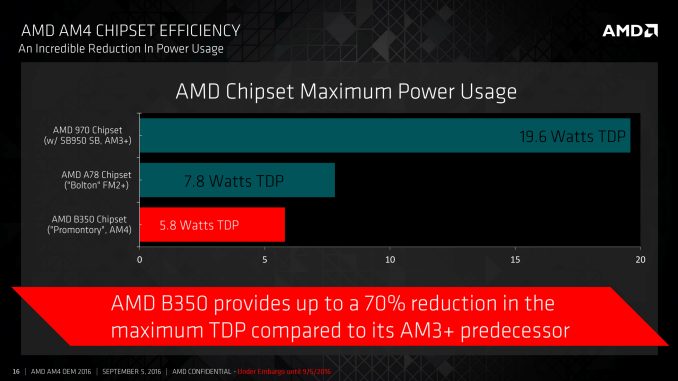AMD 7th Gen Bristol Ridge and AM4 Analysis: Up to A12-9800, B350/A320 Chipset, OEMs first, PIBs Later
by Ian Cutress on September 23, 2016 9:00 AM ESTThe Two Main Chipsets: B350 and A320
Despite all the crazy potential that might come from playing with PCIe, if a user wants more than a couple of SATA ports or x1 slots, the chipset is there to provide. For the Bristol Ridge OEM launch, there are two main chipsets with a further three aimed more at embedded platforms. We’ll focus more on the first two.
It’s worth noting that AMD has specifically listed that the B350 chipset is not the premium chipset for AM4. We know that Zen will be a part of the AM4 socket and ecosystem, and it would seem that there is at least one specific chipset for the high-end desktop market set to come later. Feel free to speculate.
The B350 and A320 chipsets are mostly identical, using the PCIe 3.0 x4 from the CPU and offering a variety of SATA, USB and PCIe 2.0 connectivity. The PCIe 2.0 lanes, six on the B350 chipset and four on the A320 chipset, support x1, x2 and x4 modes for an array of different controllers. Perhaps the interesting thing here is the support of USB 3.1 at 10 Gbps, which is provided as native support from the chipset.
The main provider of USB 3.1 controllers in the market currently, ASMedia, has been floated around as a partner with AMD in designing these chipsets. We asked AMD if ASMedia was involved, and to what extent, in the development or IP of the hardware. We were told that while the IP is with AMD, ASMedia were bought on as a partner in some fashion (most likely as a design firm or a consultant) to help produce the hardware. We were informed that the chipsets are manufactured at TSMC using a 55nm process, which is a much cheaper process than 28nm or 16nm.
An additional aside, the chipset USB 3.1 ports do not support reversible Type-C natively. We have been informed that a re-driver chip is required to support the revisable connectivity, which is a minor additional IC required by the OEMs.
Aside from the native USB 3.1 output, AMD’s chipset offerings are far behind Intel’s current implementation, affording up to 20 PCIe 3.0 lanes from their chipset despite the same uplink equivalent. This is partly because Intel’s chipset has steadily grown and looks more like a PCIe switch itself. AMD is claiming that the external B350 chipset, compared to the older AM3 platforms, comes down from 19.6W TDP to 5.8W TDP.















122 Comments
View All Comments
msroadkill612 - Wednesday, April 26, 2017 - link
Good post. Ta.Yep, for well over a decade, we hear from sisc fans how they are the future, yet i seem to live in a world where further miniturisation is the key to progress, and what better way than cisc on a single wafer, using commonly 14nm nodes, soon to be 7nm from GF.
Intuitively, Spread out, discrete chips cant compete with "warts and all" ciscS.
As it looks now, the new zen/vega amd apu, seems a new plateau of SOC, and may even be favoured in server gpu/cpu processes.
we know amd can make ryzen, which is 2x4 cpu core units on one am4 socket plug.
its a safe bet vega will be huge.
we know amd can glue an above 4 core unit to a vega gpu core on one am4 socket (from raven ridge apu specs) - i.e they can mix and match cpu/gpu on one am4 socket.
we know the biggest barrier to gpuS in the form of memory bandwidth, has been removed by vegaS HBM2 memory, and placing it practically on the chip.
We know it doesnt stop there. Naples will offer 2x ryzen on one socket soonish, and there is talk of 64 core, or 8 ryzens on one socket.
So why not 8 x APUs, or a mix of ryzen cpuS & APUs for g/cpu compute apps?
pattycake0147 - Friday, September 23, 2016 - link
Pretty sure it was mainly a joke playing on the names...Ratman6161 - Tuesday, October 4, 2016 - link
I'm coming in late and trying to understand what appears to me to be a ridiculous argument. Apple A10 Vs AMD A10??? What??? Totally unrelated. Might as well add an Air Force A10 to the list since we seem to be wanting to compare everything with A10 in the name.paffinity - Friday, September 23, 2016 - link
Lol, Apple A10 would actually win.Shadowmaster625 - Friday, September 23, 2016 - link
Apple A10 is actually faster than any AMD chip at Jetstream, Kraken, Octane, and pretty much every other benchmark that measures real world web browsing performance. Such is the sad state of AMD.ddriver - Friday, September 23, 2016 - link
JS benchmarking is is a sad joke. You compare apples to oranges, as the engine implementation is fundamentally different. No respectable source would even consider such benchmarks a measure of actual chip performance.xype - Saturday, September 24, 2016 - link
I’m as "happily locked in" into Apple’s platforms as anyone, but the whole "lol A10 kicks x86 ass" thing is getting retarded. It’s a fine CPU, sure, but how people can’t comprehend that it’s designed for a whole different set of usage scenarios is beyond me.Now, that’s not to say Apple isn’t working on a desktop class ARM CPU/GPU combo, but _that_ would be a real surprise.
Meteor2 - Saturday, September 24, 2016 - link
It's a measure of end-user experience, however.Alexvrb - Sunday, September 25, 2016 - link
Not necessarily. Those benches Shadow mentioned are more of a measure of a particular browser's optimizations for those benches, than anything.silverblue - Saturday, September 24, 2016 - link
Yet HSA would yield far bigger performance gains. The only issue is unlike iOS-specific optimisations which you're running into all the time, unless you're using specifically optimised software then HSA won't be helping anybody.If HSA was some intelligent force that automatically optimised workloads, I don't think anybody would dare suggest an Apple mobile CPU beating a desktop one.